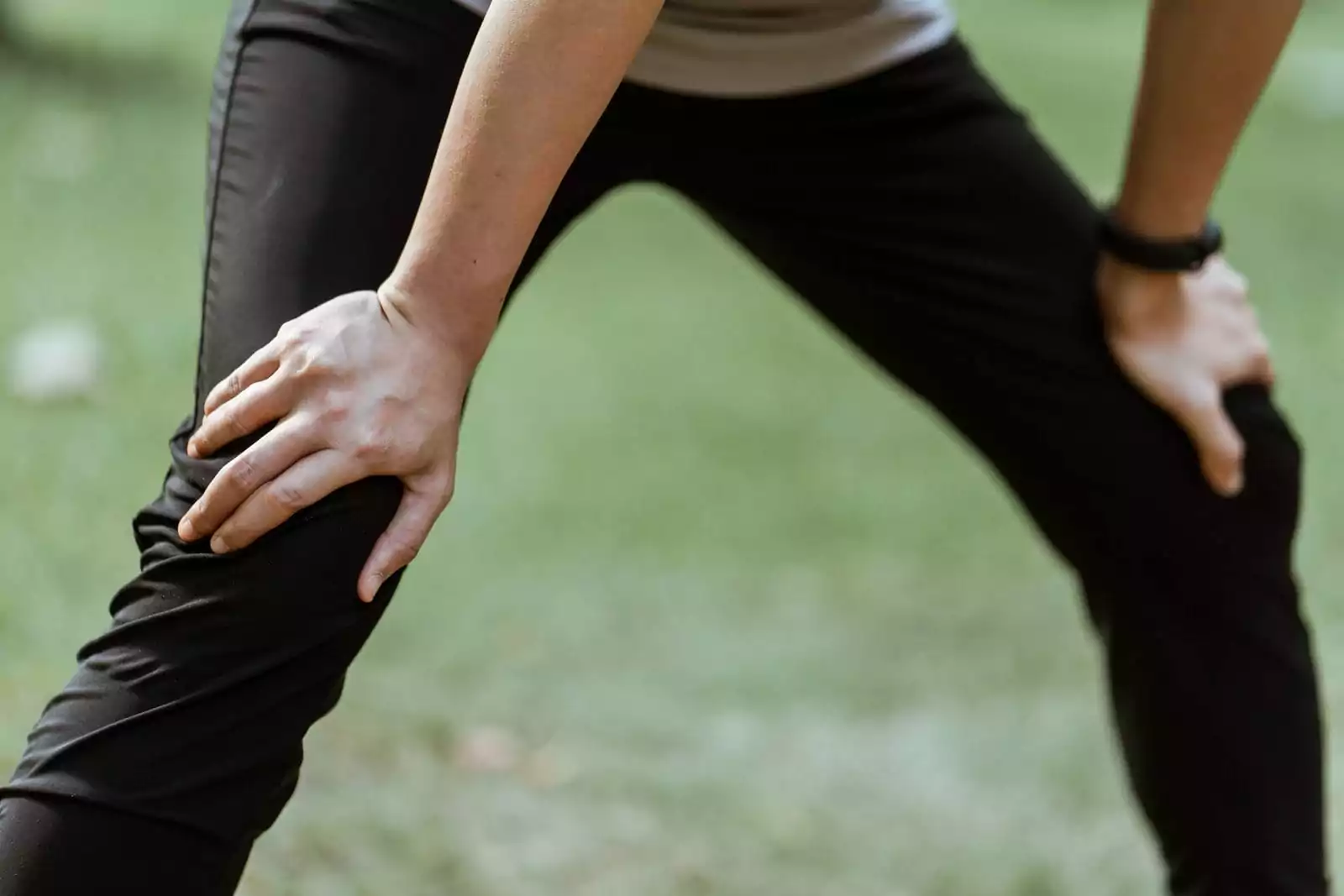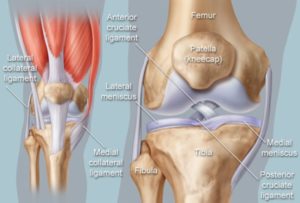
It’s the biggest joint in the body – the knee. As a hinge joint (as opposed to a ball and socket joint) it’s relatively strong, but as one of the most active joints, it also goes through the most use (and often abuse) as we go through our daily activities. It’s so easy to take them for granted, until they start hurting from overuse or one gets injured. If staying healthy equates to staying active, then, it’s in our best interest to take care of our knees as best we can to avoid injury. We invite you to read on and explore our Knee Health Guide to learn how to take care of your knees.
The knee – the joint that probably sees the most movement when it comes to activity, exercise and daily life – is responsible for giving our legs more mobility and range of motion. Can you imagine trying to walk with stick straight bones?! More importantly, knees are shock absorbers too, helping take on a lot of the force our body experiences through normal everyday movements like walking and climbing, to high impact exercise like jumping and running. Our knee joints take on a lot of wear and tear! Healthy knees are constantly moving knees, which may seem counterintuitive since a lot of knee are at higher risk of injuries from overuse. The joint needs a constant flow of synovial fluid (the liquid which lubricates and reduces friction between the parts of each joint), and constant movement helps move the fluid around. When you sit still, joints ‘stiffen up’ and movement is more difficult.
The knee itself connects the three bones of the leg (femur, tibia and fibula) along with the patella (kneecap), cartilage (the meniscus) and ligaments. The muscles of the legs work together with the knee to both bend the leg (by pulling with the hamstring behind the thigh) and extension (by squeezing the quadriceps on the front of the thigh).
As the biggest and most complex joint in the body, it’s highly susceptible to injury during physical activity. Common complaints and injuries include:
Anterior Cruciate Ligament (ACL) tear. One of the more serious injuries, an ACL tear damages the ligament that provides serious stability for the knee, and untreated can lead to long term issues. High impact, such as a landing from a higher platform and other contact sports often can result in an ACL tear. While some milder tears can heal themselves, surgery can be required for the most serious cases.

Kneecap fracture. A patella fracture is fairly common with a high impact injury – such as falling hard directly onto the knee or in cases where the individual has an underlying condition like osteoarthritis. A cast or splint is often applied to help immobilize the joint for the fastest healing. Depending on the severity of the fracture, bearing weight on the affected leg may or may not be advised.
Meniscus tears. Also commonly known as cartilage tears, meniscus tears are a common injury, often caused by overuse, age, or twisting the joint. The affected individuals often report feeling a ‘pop’, followed by swelling and joint discomfort. Depending on the area of the knee where the tear is located, the injury may heal on its own or it may require surgery.
Bursitis. As previously mentioned, our joints have fluid-filled sacs called bursae, which contain synovial fluid that helps lubricate joints. If those sacs become inflamed (most often due to overuse), extreme swelling and discomfort can be the result. Normally, rest is the best recovery technique. It’s important to note that this particular injury can be time-consuming to heal – total rest or compression knee benefits from knee compression sleeves is best!
Tendonitis. This term refers to generalized inflammation, often in the kneecap tendon. This inflammation frequently is caused by sports and activities that involve a lot of jumping. This is another injury where rest often is the best solution.
The important thing to note with any knee injury is that medical attention is never a bad idea. Even if it turns out to be a mild injury that only requires some rest, having a professional opinion can give you the best chance of returning to pre-injury mobility.
As the saying goes, ‘an ounce of prevention is worth a pound of cure’ and this definitely is great advice for prevention of knee injuries.
Protecting our joints starts by building up the muscles that support those joints. For optimal knee injury prevention, focusing on lifting weights or resistance training the legs, primarily the quadriceps and hamstrings (the muscles that line the front and back of our upper legs) is essential. When it comes to strength training, you have lots of options. Utilizing weight lifting machinery that is designed to work the legs, using barbells or free weights, integrating resistance bands, or simply using body weight if you’re a beginner can all provide excellent muscle building work to strengthen the legs to support the knees better. Not sure where to start? Consider hiring a personal trainer for a couple sessions to teach you proper form, because using good technique is crucial to getting the benefit from lifting but also to preventing the very injury you’re working toward helping!

Flexibility training and yoga. Related to strength training, improving your flexibility is another way to prevent knee injuries, and not necessarily in ways you might think. Having more limber muscles does allow for greater mobility, and muscles that are too tight can contribute to knee injuries. But in addition to that, stretching exercises can also help move the synovial fluid within joints, which provides better joint mobility all on its own with the extra lubrication. Stretching also contributes to greater blood flow (which works for prevention AND healing!). Related to flexibility training, yoga also can serve to both improve flexibility and strength at the same time. Many poses use little motion but require a lot of strength to hold the various standing poses. Both stretching in general and yoga can be a great benefit toward preventing knee pain and injury.
Flexibility training and yoga. Related to strength training, improving your flexibility is another way to prevent knee injuries, and not necessarily in ways you might think. Having more limber muscles does allow for greater mobility, and muscles that are too tight can contribute to knee injuries. But in addition to that, stretching exercises can also help move the synovial fluid within joints, which provides better joint mobility all on its own with the extra lubrication. Stretching also contributes to greater blood flow (which works for prevention AND healing!). Related to flexibility training, yoga also can serve to both improve flexibility and strength at the same time. Many poses use little motion but require a lot of strength to hold the various standing poses. Both stretching in general and yoga can be a great benefit toward preventing knee pain and injury.
Foam rolling. Foam rolling massage can provide additional benefits besides the obvious pain relief of using the roller on tight, sore muscles. Using a foam roller can aid in injury prevention by helping relax those tight muscles that could then move improperly or with less mobility, then leading to potential injury. Example, if a quad muscle is too tight, and after a tough workout, it develops a trigger point (a ‘knot’ as we often hear it called). During the next workout, if that trigger point persists, it could lead to the knee giving out (resulting in injury) or in the muscle not supporting the knee properly and it twists incorrectly. Using foam rollers properly is important – make sure you refer to a reputable source when learning how to roll various areas of the body.
Proper body mechanics. As previously mentioned, using proper technique when exercising or in any movement is very important in reducing your risk of joint and knee injury. Learning correct exercise techniques is a given – it is not recommended that you exercise without some training to do the exercises perfectly so you don’t get hurt. Some of the best leg strengthening exercises like squats, step-back lunges and certain leg extensions can seriously damage the knee if done improperly – and it’s quite easy to not realize you’re doing them improperly. Learn from a professional. When it comes to every day activities, don’t get so rushed that you use poor body mechanics, like twisting your body that could put stress on your knees, or lifting heavy items improperly.
Nutrition. A healthy diet cannot be overlooked when it comes to joint health. Every part of our bodies require specific nutrition to function optimally, and joints are a part of that. Eating a healthy balanced diet by integrating various fruits, veggies, legumes, grains and protein will help keep the joints healthy, but there are some specific foods that you can introduce into your diet as an added layer of protection. Protein sources like salmon and plain Greek yogurt, produce like cherries and red peppers, and grains like oatmeal all have joint protecting properties. Seasonings like garlic and turmeric also can be beneficial.
Compression sleeves for stability. If you’re asking if knee compression sleeves actually help protect your knees, the answer is 100% yes they can. By wearing a compression sleeve preventatively before an injury actually occurs, you can prevent a fair amount of pain and even surgery. Often, compression sleeves can be beneficial for those with previous injuries and the sleeves can prevent reinjury. With the benefits that are provided by wearing knee braces or compression sleeves, it can be tempting by some to wear the piece all day long, but the truth is you’re better off just wearing it during bouts of movement when injury is likely. Constant wear can also lead to some weakening of the supporting muscles, making the benefits of the brace counteract the weakening of the muscles that help the joint. Finding highly rated knee compression sleeve reviews online can help.
Recovery
Already got an injury? Best first steps are to rest and see a medical professional! Taking a break from movement will allow inflammation to subside and help you figure out if it’s a serious knee injury. Seeing a medical professional is never a bad idea – it can prevent further injury and they can provide you advice on how to properly recover, whether it be through rest, physical therapy, sports medicine or even surgery.
Rest and Knee Compression Sleeves. Knee compression sleeves work in a few different ways. The compression itself helps reduce both pain and inflammation, pushing accumulated fluid away from the injury. It can help improve circulation which can improve healing times. The compression also can provide additional stability if supporting muscles have been weakened. But sometimes rest is the best medicine – allowing the knee to recover on its own is often a great option but if you try to push it too far too fast, it can result in needing more extreme treatment, like therapy or surgery.
Medical Treatment. Physical therapy is often a modality of health care that can be used both before surgery or after if warranted. Often physical therapy can prevent the need for surgery if employed early enough after the injury has occurred. Should surgery be required, don’t delay. Many types of knee surgery can be less successful if treatment is put off for too long. It is highly recommended to get a medical opinion as soon as possible to increase the odds of regaining as much function as possible. Physical therapy also is generally a necessary part of aftercare following surgery – in order to regain mobility, a physical therapist will use passive movements to manipulate the knee in different ways to improve healing and mobility.